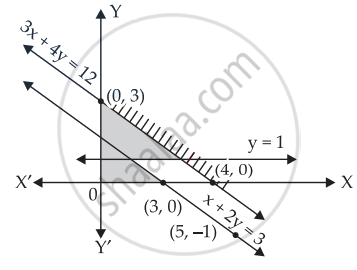Advertisements
Advertisements
Question
Show that the following system of linear inequalities has no solution x + 2y ≤ 3, 3x + 4y ≥ 12, x ≥ 0, y ≥ 1
Solution
Given that: x + 2y ≤ 3, 3x + 4y ≥ 12, x ≥ 0, y ≥ 1
Let x + 2y = 3
⇒ x = 3 – 2y
| x | 3 | 1 | 5 |
| y | 0 | 1 | –1 |
Now putting (0, 0) in x + 2y ≤ 3
0 + 0 ≤ 3
0 ≤ 3 True
Therefore, the shading will be towards (0, 0)
Consider the in equation 3x + 4y ≥ 12
Let 3x + 4y = 12
| x | 0 | 4 | 2 |
| y | 3 | 0 | 1.5 |
Putting (0, 0) in 3x + 4y ≥ 12
0 + 0 ≥ 12
0 ≥ 12 False
Therefore, shading will be on the opposite side of the graph of line.
x ≥ 0 ⇒ Positive side of y-axis will be shaded.
And y ≥ 1 ⇒ Upperside of y = 1 will be shaded.
Let us now draw the graph.
It is clear from the graph that there is no common shaded region.
Hence, the solution is null set.
APPEARS IN
RELATED QUESTIONS
Solve the following system of inequalities graphically: x + y ≤ 6, x + y ≥ 4
Solve the following system of inequalities graphically: 2x + y≥ 8, x + 2y ≥ 10
Solve the following system of inequalities graphically: 5x + 4y ≤ 20, x ≥ 1, y ≥ 2
Solve the following system of inequalities graphically: x – 2y ≤ 3, 3x + 4y ≥ 12, x ≥ 0, y ≥ 1
Solve the following system of inequalities graphically: 3x + 2y ≤ 150, x + 4y ≤ 80, x ≤ 15, y ≥ 0, x ≥ 0
Solve the following system of inequalities graphically: x + 2y ≤ 10, x + y ≥ 1, x – y ≤ 0, x ≥ 0, y ≥ 0
Find all pairs of consecutive odd positive integers, both of which are smaller than 10, such that their sum is more than 11.
Find all pairs of consecutive odd natural number, both of which are larger than 10, such that their sum is less than 40.
The marks scored by Rohit in two tests were 65 and 70. Find the minimum marks he should score in the third test to have an average of at least 65 marks.
A solution is to be kept between 30°C and 35°C. What is the range of temperature in degree Fahrenheit?
To receive grade 'A' in a course, one must obtain an average of 90 marks or more in five papers each of 100 marks. If Shikha scored 87, 95, 92 and 94 marks in first four paper, find the minimum marks that she must score in the last paper to get grade 'A' in the course.
A company manufactures cassettes and its cost and revenue functions for a week are \[C = 300 + \frac{3}{2}x \text{ and } R = 2x\] respectively, where x is the number of cassettes produced and sold in a week. How many cassettes must be sold for the company to realize a profit?
How many litres of water will have to be added to 1125 litres of the 45% solution of acid so that the resulting mixture will contain more than 25% but less than 30% acid content?
A solution of 8% boric acid is to be diluted by adding a 2% boric acid solution to it. The resulting mixture is to be more than 4% but less than 6% boric acid. If there are 640 litres of the 8% solution, how many litres of 2% solution will have to be added?
The water acidity in a pool is considered normal when the average pH reading of three daily measurements is between 7.2 and 7.8. If the first two pH reading are 7.48 and 7.85, find the range of pH value for the third reading that will result in the acidity level being normal.
Write the set of values of x satisfying the inequation (x2 − 2x + 1) (x − 4) < 0.
Write the solution set of the equation |2 − x| = x − 2.
Write the set of values of x satisfying |x − 1| ≤ 3 and |x − 1| ≥ 1.
Write the solution set of the inequation \[\left| \frac{1}{x} - 2 \right| > 4\]
Write the number of integral solutions of \[\frac{x + 2}{x^2 + 1} > \frac{1}{2}\]
Write the solution of set of\[\left| x + \frac{1}{x} \right| > 2\]
Write the solution set of the inequation |x − 1| ≥ |x − 3|.
Find the graphical solution of the following system of linear inequations:
3x + 2y ≤ 1800, 2x + 7y ≤ 1400
Solve the following system of linear inequalities:
3x + 2y ≥ 24, 3x + y ≤ 15, x ≥ 4
Show that the solution set of the following system of linear inequalities is an unbounded region 2x + y ≥ 8, x + 2y ≥ 10, x ≥ 0, y ≥ 0.
